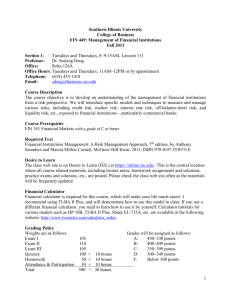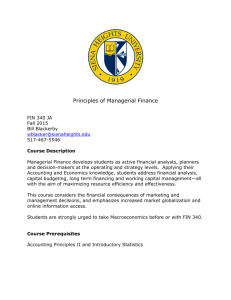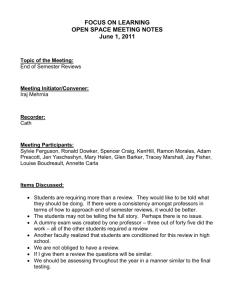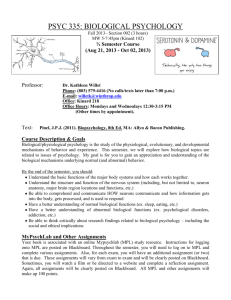Winthrop University
advertisement
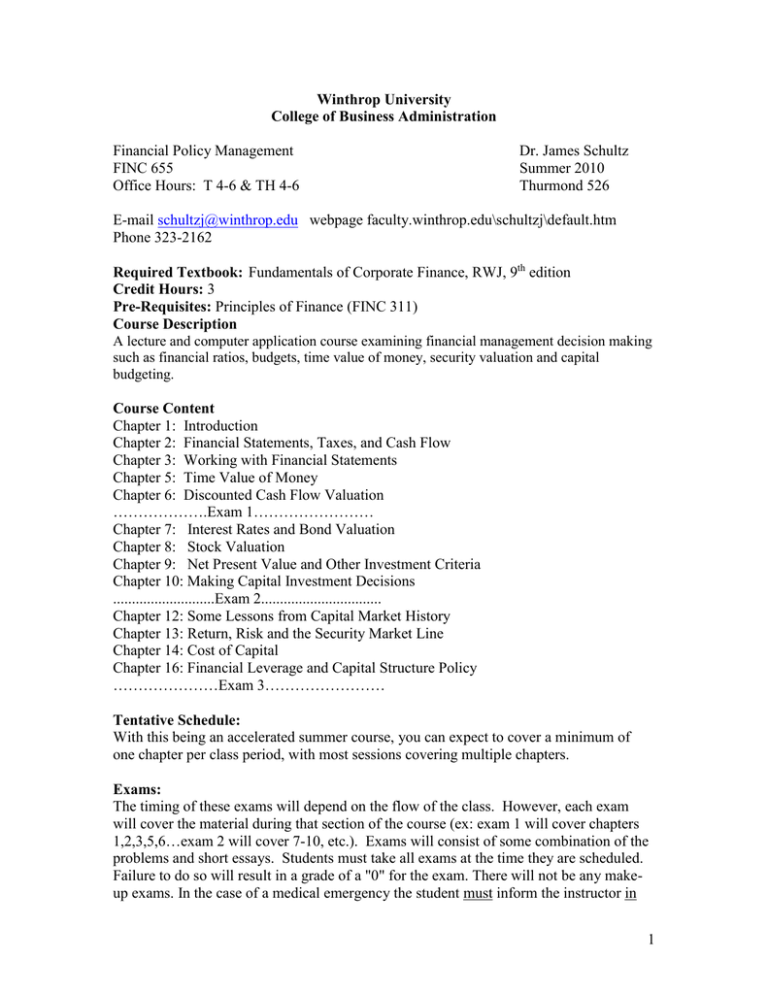
Winthrop University College of Business Administration Financial Policy Management FINC 655 Office Hours: T 4-6 & TH 4-6 Dr. James Schultz Summer 2010 Thurmond 526 E-mail schultzj@winthrop.edu webpage faculty.winthrop.edu\schultzj\default.htm Phone 323-2162 Required Textbook: Fundamentals of Corporate Finance, RWJ, 9th edition Credit Hours: 3 Pre-Requisites: Principles of Finance (FINC 311) Course Description A lecture and computer application course examining financial management decision making such as financial ratios, budgets, time value of money, security valuation and capital budgeting. Course Content Chapter 1: Introduction Chapter 2: Financial Statements, Taxes, and Cash Flow Chapter 3: Working with Financial Statements Chapter 5: Time Value of Money Chapter 6: Discounted Cash Flow Valuation ……………….Exam 1…………………… Chapter 7: Interest Rates and Bond Valuation Chapter 8: Stock Valuation Chapter 9: Net Present Value and Other Investment Criteria Chapter 10: Making Capital Investment Decisions ...........................Exam 2................................ Chapter 12: Some Lessons from Capital Market History Chapter 13: Return, Risk and the Security Market Line Chapter 14: Cost of Capital Chapter 16: Financial Leverage and Capital Structure Policy …………………Exam 3…………………… Tentative Schedule: With this being an accelerated summer course, you can expect to cover a minimum of one chapter per class period, with most sessions covering multiple chapters. Exams: The timing of these exams will depend on the flow of the class. However, each exam will cover the material during that section of the course (ex: exam 1 will cover chapters 1,2,3,5,6…exam 2 will cover 7-10, etc.). Exams will consist of some combination of the problems and short essays. Students must take all exams at the time they are scheduled. Failure to do so will result in a grade of a "0" for the exam. There will not be any makeup exams. In the case of a medical emergency the student must inform the instructor in 1 advance of his or her absence from the exam. Note, the best way to contact the instructor is through e-mail. As expected the student must provide sufficient evidence to support his or her absence. No cell phones will be allowed in class during exam periods. Students will not be allowed to leave the classroom during exam periods. Violation of any of these policies will result in a grade of “0” for the exam. Homework: Problems will be suggested throughout the class as practice for the exams, but no official homework will be collected. Project: Each team will choose a company in the S&P 500 to analyze throughout the semester. Official details of this project will be given as the semester gets underway. Bonus Quizzes: Bonus quizzes will be given randomly throughout the semester to reward those students who stay on top of their studies. A total of 20 bonus quizzes will be administered with each quiz worth a total of 5 bonus points. Each student’s bonus point total will be multiplied by 6% to determine his/her bonus point award. For example, a student who earns 80 bonus points for the semester will receive 6% of 80, or 4.8 bonus points on his/her final grade in the class. Therefore, if this student had an overall grade of 80 in the class he/she would now have 84.8. The professor reserves the right to award bonus points by other means as well (answering questions in class, working problems on the board, etc.). Bonus quizzes cannot be made up. Grading: Exam One Exam Two Exam Three Project Total 26.7% 26.7% 26.7% 20% 100% Grades: 90-100 80-89 70-79 60-69 50-59 A B C D F Any student who is still enrolled in the course after the withdrawal deadline will be given a grade ("A" through "F"). Furthermore, the professor reserves the right to increase a student’s grade beyond that which was earned due to “intangible” factors such as, but not limited to: effort, participation, improvement over the semester, etc. Powerpoint slides and course materials: 2 Throughout the semester course documents will be posted online at my website. Attendance Policy: Attendance will not directly be graded. It is the student’s responsibility to obtain any materials from missed classes. Bonus quizzes will be used to indirectly record attendance. Students with Disabilities: Winthrop University is dedicated to providing access to education. If you have a disability and require specific accommodations to complete this course, contact Gena Smith, Program Director, Services for Students with Disabilities, at 323-3290. Once you have your official notice of accommodations from Services for Students with Disabilities, please inform me as early as possible in the semester. Student Conduct Code: As noted in the Student Conduct Code: “Responsibility for good conduct rests with students as adult individuals.” The policy on student academic misconduct is outlined in the Student Conduct Code Academic misconduct Policy in the Student Handbook online (http://www2.winthrop.edu/studentaffairs/handbook/StudentHandbook.pdf). Professionalism: The College of Business Administration is preparing students for success in the business world. Behavior that is not appropriate in a place of business is not appropriate in the classroom. Have respect for yourself and those around you: no text messaging, no head phones, no sleeping, no talking during lectures, quizzes, or exams. The class belongs to all students. Be considerate of others, be engaged but do not dominate the class with excessive comments or questions. All University conduct policies apply as well. Course Goals: Explain the basic criterion for every financial decision Assess the financial health of a company Describe the basic function of financial markets and explain why these markets are important to financial managers Explain how financial assets are valued in the market Explain how a company raises money by selling stocks, bonds, and other financial assets Calculate interest rates for different types of securities Calculate future values and present values for both lump-sums and annuities Compute a company’s cost of capital Use the proper technique for making investment decisions Understand how many of the tools we apply at the corporate level, are also applicable at the personal level Analyze a company from the perspective of a portfolio manager in an effort to determine this company’s potential as an investment 3 Examine the capital structure tradeoff between debt and equity and understand how this fits into an optimal capital structure Course objectives: 1. Understand the analysis of a firm’s financial condition. 2. Learn techniques of financial planning and budgeting. 3. Learn the concept of risk-reward tradeoff. 4. Understand security valuation. 5. Learn Capital Structure decisions. 6. Study the techniques of corporate investment decision. Students will be asked to apply problem-solving as well critical thinking methods to financial situations. Furthermore, an understanding of ethical considerations will be stressed. Calculators: The TI BA II Plus is the preferred calculator but you may use any other financial calculator. A financial calculator is required for this course. If you select a calculator other than the TI model, you will likely be on your own in learning how to use it. I will instruct the class how to use the TI model for all problems in the class. Study Methods: The best method of studying for this course is to attend all classes, skim each chapter prior to class, take good lecture notes, refine and study your notes, read the chapters in their entirety, and work the practice problems and questions. During your readings, pay particular attention to the sections of text that overlap with lecture notes. This is a graduate level course, so you can expect the pace to be rather quick at times. Note: Remember it is your responsibility to contact me in the event of an emergency. There are two ways that I can be reached: through e-mail and a phone call to my office. Be thorough and exhaust both options if necessary. Any changes to the syllabus will be discussed in class and formalized through an official email to all registered students. 4 5
